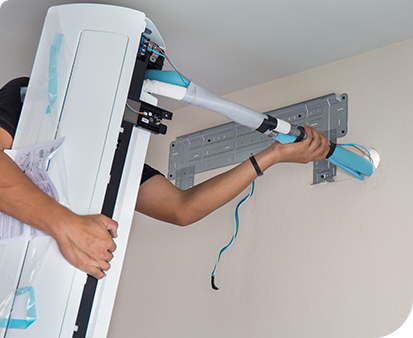How To Install a Split Air Conditioner System. Back to back installation

new
In summer, a split air conditioner system is an excellent choice for keeping your home cool and comfortable. Besides that, these units are quieter, easy to install, and more environmentally friendly than central air conditioning. This A/C unit is ductless. All you have to do is install the cooling unit in the interior part and the compressor and condenser unit on the exterior part, then run piping between units and a power cable. In case you don't like to hire a professional to install an air conditioner with a split system, but you have some plumbing and electrical job experience, you can install the unit. Every air conditioning unit is unique to its producer, but the installation's general process is the same. Various split air conditioner systems are slightly different, but all have the same installation process. The following steps will give you a guide on how to install a split air conditioner system.
Tools required: flaring tool, hammer drill, cordless drill, screwdrivers, hammer, adjustable wrenches , spirit level ,PVC pipes cutter, pliers, deburring tool, vacuum pump, manifold gauge with refrigerant hoses, vacuum gauge,
Step 1:
Secure the brackets for installation
For the indoor unit, you need to choose an appropriate location. The suitable position should be moderately central in the room, have no existing pipes or cables, ideally have studs for additional support in the wall, and usually be out of sunrays and away from heating systems that will impact the function of the air conditioner. The stiffening brackets that will sustain the indoor unit can be secured to the wall by gyprock wall plugs or nylon plugs for brick or concrete wall once you have selected a location.
Step 2:
Drilling holes for the links
The next step is to mark a hole on the mounting plate and drill a hole d65mm or d80mm depends of the aircon size so all way to the exterior through the wall. It is essential to check that the wall been pierced does not have electrical or plumbing linkages.
Step 3:
Run the tubes through the hole
Pass the necessary electrical wiring (it is usually 4 core 1.5mm cable) and refrigeration pipes via the holes once the holes are carved. It will link the system's interior and exterior sections. The system must be supplied with all these lines, and they should all be appropriately insulated.
Step 4:
Mounting the indoor unit and securing it
The next step is to connect the system's interior aspect to the mounting brackets and fix everything to the wall. Check wall mount unit level with spirit level .As this assists with drainage, it can be flip away at a low angle.
Step 5:
Mount the unit for outdoor use
The largest and heaviest portion of the exterior system is the external condenser unit, so it must be well protected. Usually, wall mount air conditioner condensers are placed on a new or existing concrete slab. To avoid extra refrigerant charge and comply manufacturer indoor and outdoor pipes should be less than 15m long.
Step 6:
Link the indoor unit to the outdoor condenser
Next is to connect refrigeration pipes and wires to the outdoor unit. Before it is connected, make the refrigerant pipes are clean.
Step 7:
Secure the piping on the wall
If the pipes have to migrate along the wall before they approach the outdoor unit, safely fix them with clamps in the place provided in the pack and protect from weather by metal or plastic trunking.
Step 8:
Seal the hole
Now that the split air conditioner system set up is successful, the hole in the wall must be sealed by weatherproof silicone to avoid water leakage. Before you turn on your new air conditioner, leave the silicone to dry for as much as the packaging directs.
Step 9:
Commissioning
To commission new split conditioner you need to vacuumize system down to 500 microns by vacuum, pump and hold it for 5 min to check the leakage. Once you have done this procedure you can open refrigerant valves on condenser unit and let the refrigerant flow in the system. Now you air conditioner is ready to use.
The split air conditioning system gives greater flexibility in cooling any room. In a multi-split system, you can even connect multiple indoor units to the same compressor. The split air conditioner system installation is much simpler and cheaper than ducted air conditioning installation because the connections are less obstructed and you don’t need to run flexible ducts. However, it is still a complicated job that refrigeration technician needs to handle. Be aware that is regulated by the government in Australia. Even if you understand how to set up a split air conditioner system, you cannot do it yourself if you are not suitably qualified and licensed. Not only does it put you and your family at risk of electric shock or contaminate your home by refrigerant and other hazards, but if something goes wrong, your guarantee will also be invalid.
Trying to save money by installing DIY air conditioning could be more expensive, not to mention risky, in the long run. Instead, it would be best if you hire licensed company or technician to do it.
12.02.2021

IZONE

Obligation free quotes

Best competitive price on the market

ARC certified

Licenced and insured installation

Fully equipped technicians

5 year parts and labour warranty





